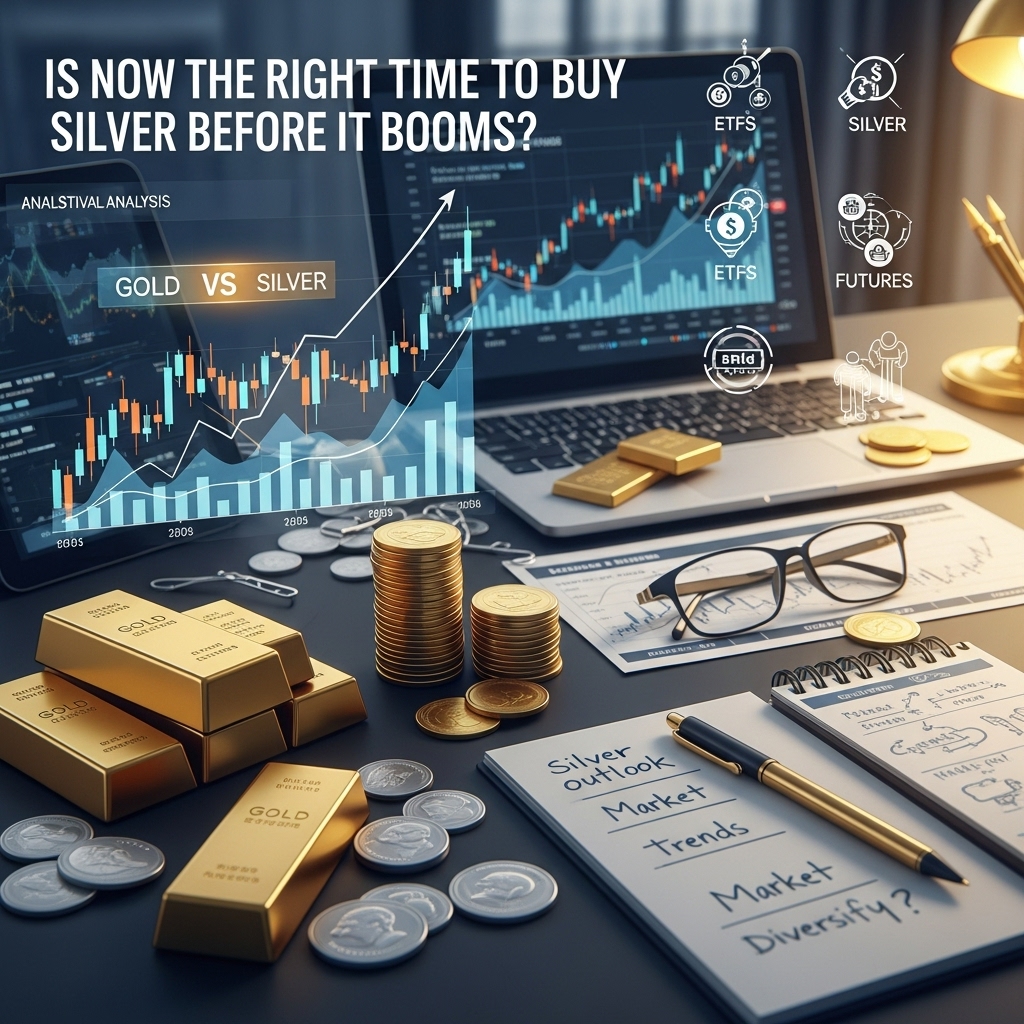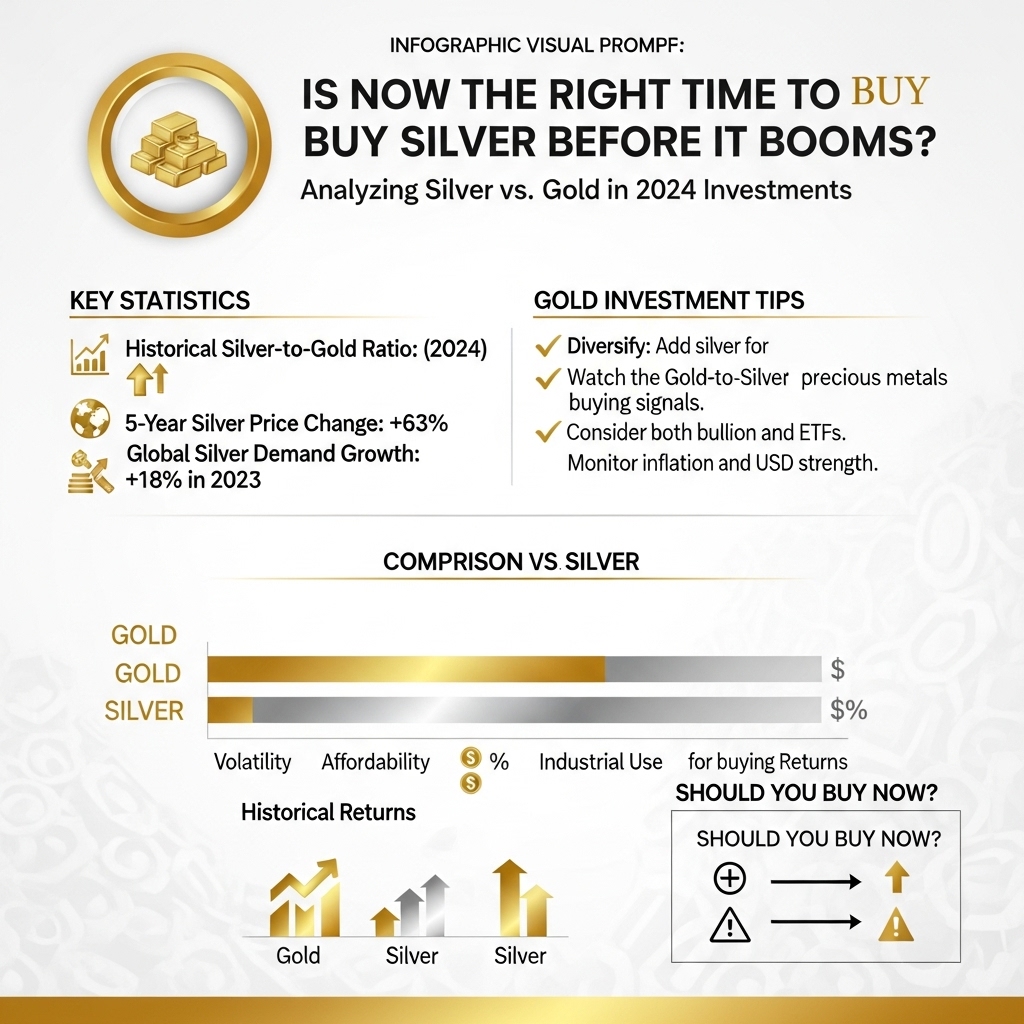Is Now the Right Time to Buy Silver Before It Booms?
Gold has been dazzling investors in 2024, consistently hitting new highs and reinforcing its reputation as a steadfast store of value. As inflation jitters and geopolitical tensions spur demand for safe-haven assets, gold’s resilience has attracted both seasoned and new investors looking for stability. Yet, amid this golden glow, a pressing question arises: could silver be the next precious metal poised for a breakout—and is now the perfect moment to diversify before the silver market truly heats up?
In this post, we’ll explore the current trends shaping both gold and silver markets, analyzing key financial factors influencing their prices. We’ll dig into historical patterns that reveal how silver often follows gold’s upward movements, sometimes with even more dramatic gains. Plus, we’ll break down the strategic benefits of adding silver to your investment mix—especially for those already invested in gold and looking for ways to maximize portfolio growth and hedge against volatility.
Understanding the gold-to-silver market relationship is essential for forward-thinking investors. With gold prices already soaring, the possibility of silver lagging behind (and then surging) could present a timely opportunity. Whether you’re a longtime gold investor or just starting to build your portfolio, examining the silver market’s potential now could help you capture gains before the crowd catches on. Let’s dive into the data and expert insights to see if it’s time to act.
Gold Market Analysis and Key Insights
Gold Price Trends and Market Data
Gold has historically acted as a barometer of economic sentiment and a safe haven during periods of volatility. As of mid-2024, gold prices have stabilized near $2,300 per ounce, marking a notable rise from 2023 levels, which hovered around $1,900. This upswing is largely attributed to persistent inflation, global geopolitical tensions, and uncertain economic growth forecasts, especially in the US and Europe. According to the World Gold Council, central banks have continued to increase their gold reserves, reflecting confidence in gold’s long-term value. In tandem, gold ETF inflows have rebounded, signaling increased investor interest.
Investment Benefits and Considerations
Gold’s appeal as an investment stems from its dual nature: it serves both as a store of value and a hedge against inflation. Unlike other assets, gold often preserves capital during periods of market decline, providing portfolio diversification. Its liquidity, global acceptance, and historical resilience further enhance its desirability. However, investors should consider that gold, while stable, does not generate income like dividends or interest. Its price can be influenced by factors such as central bank policy shifts, dollar strength, and shifts in risk sentiment, leading to short-term volatility.
Additionally, investing directly in physical gold involves considerations like storage and insurance costs. For those seeking exposure without these complexities, gold-backed ETFs and mining stocks are popular alternatives. Each approach carries unique risk-return profiles that should be evaluated according to individual investment goals.
Expert Recommendations
Most analysts suggest that gold remains a prudent component of a diversified portfolio, especially in today’s uncertain macroeconomic environment. JP Morgan and Goldman Sachs continue to forecast robust demand for gold through late 2024, with some expecting potential new price highs if inflation persists or geopolitical risks intensify. Experts generally recommend allocating 5-10% of investment portfolios to gold as a strategic hedge. However, they caution against overexposure, emphasizing the importance of balancing gold with other assets to mitigate volatility and optimize returns.

Gold Investment Strategies and Options
When considering if now is the right time to invest before a potential price boom, understanding the various gold investment strategies and options is crucial. Investors can choose from several methods: physical gold (such as bullion bars and coins), gold ETFs (exchange-traded funds), gold mining stocks, and gold mutual funds. Each approach caters to different risk appetites and investment horizons.
Physical gold offers direct ownership and is favored for its tangibility and role as a hedge against economic uncertainty. However, it requires secure storage and is less liquid than other forms. Gold ETFs provide exposure to gold prices without the need for physical storage, offering ease of trading and lower transaction costs. Gold mining stocks allow investors to benefit from potential operational leverage if gold prices rise, though these stocks are influenced not only by gold prices but also by company-specific factors, adding another layer of risk. Mutual funds focused on gold diversify across multiple mining companies, reducing company-specific risks.
Risk assessment should involve evaluating your portfolio’s overall risk tolerance and investment objectives. Gold typically acts as a diversification tool and a hedge against inflation and currency fluctuations. Conventional wisdom suggests allocating 5-10% of a portfolio to gold, but this can vary based on market conditions and personal risk tolerance.
When comparing these investment methods, consider accessibility, liquidity, potential returns, and storage costs. Physical gold is more secure but less flexible, while ETFs and stocks are typically easier to buy and sell.
Market timing can be challenging given gold’s volatility and sensitivity to global events. Rather than trying to predict short-term price movements, many investors find success with dollar-cost averaging—consistently buying over time to reduce the impact of market fluctuations.
Ultimately, a balanced approach that considers your individual goals, risk tolerance, and market outlook is vital for capitalizing on opportunities in gold investment.
Market Performance and Outlook
Silver’s performance has historically mirrored economic cycles and investor sentiment toward safe-haven assets. In the past decade, silver prices have seen significant volatility—reaching nearly $50 per ounce in 2011 during debt crises, then retreating below $15 in subsequent years as markets stabilized. Recently, silver has steadied between $22 and $26 per ounce, buoyed by inflation fears and renewed industrial demand.
Currently, global uncertainties such as inflationary trends, geopolitical tensions, and changing interest rate policies have rekindled interest in precious metals. Unlike gold, silver enjoys significant industrial usage—in electronics and green technologies like solar panels—which strengthens its demand profile amid global sustainability pushes. This dual role helped silver outperform in 2020, briefly surging above $28 per ounce at the pandemic’s height.
Looking ahead, analysts are cautiously optimistic. Silver’s supply remains tight, with mining output hindered by past underinvestment and regulatory delays. Meanwhile, the energy transition and electric vehicle market expansion are expected to boost long-range demand. While some volatility is likely as interest rates and the U.S. dollar fluctuate, many experts foresee silver testing and potentially surpassing its recent highs should inflation persist or economic uncertainty deepen.
Although this analysis focuses on silver, gold’s price trends often influence silver through investor psychology and macroeconomic linkages—such as interest rates and currency movements. Silver’s affordability and growth prospects may make now an opportune moment for investors, particularly if economic headwinds support further rallies in precious metals.
Frequently Asked Questions About Gold Investment
Is silver a good alternative to gold right now?
Yes, many investors see silver as a complementary asset to gold, especially when gold prices are high. Silver often lags gold in rallies, offering potential for appreciation if it catches up. Its industrial uses may add further upside.
How does silver’s price movement compare to gold’s?
Silver is more volatile than gold and tends to have larger price swings. It can outperform gold during bull markets but may fall more sharply during downturns. This volatility can present both risks and opportunities.
What factors could cause a silver price boom?
Potential catalysts include increased demand for green technology, inflationary pressures, supply shortages from mining, and safe-haven buying during economic uncertainty. Silver’s dual role as both an industrial and precious metal can supercharge rallies under the right conditions.
Is now a risky time to invest in silver?
All investments carry risk, and silver’s volatility means prices can decline quickly. However, if current economic trends persist—such as inflation and geopolitical tension—silver could benefit. Diversifying with both silver and gold might mitigate risk.
Should I buy physical silver or invest in ETFs?
Physical silver (coins or bars) avoids counterparty risk but requires secure storage. Silver ETFs or mining stocks offer liquidity and easy access but have different risks (such as fund management or company performance). Your choice depends on investment goals and risk tolerance.

Final Thoughts on Gold Investment
In summary, while silver is garnering attention for its growth potential, gold remains a cornerstone for savvy investors seeking stability, liquidity, and a proven hedge against market volatility. Gold’s historical resilience and strong demand make it a reliable asset in any investment portfolio, especially during uncertain economic times. If you’re considering diversifying or strengthening your holdings, now is a strategic moment to evaluate gold alongside silver. As with any investment, be sure to research thoroughly and align your choices with your long-term financial goals. Don’t miss out on the opportunity—review your investment strategy today and consider how gold can secure your financial future. Ready to take the next step? Start exploring reputable gold investment options and make informed decisions for your portfolio now!